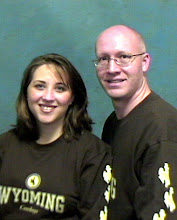We started with Virginia. I did not want to go through every frame, just check on a few to make sure the queen had been laying and to see if they were getting crowded. On the very first frame we pulled we saw two queens a few inches apart. This was very exciting. I had not seen a queen in either hive since shortly after we hived the original packages in 2009. Here is a photo of one ofthe queens.
I don't know why there were two queens in the hive or if there might have been more somewhere in there. If you look closely you can see that this queen is missing a wing. Maybe she was the old queen and is being superceded because of her injury. Who knows?
Both hives have some empty frames so there is plenty of space for the queens to lay.
During the last inspection back in April, both queens were laying in loose spotty patterns. Here is an example of their brood patterns lately.

The pattern is looking a lot better!
We came across two queens in Georgia as well. These queens were not live adult bees, though. As I pulled the top box off we found this next image on top of the frames below.

It is a photo of two queen pupae that were apparently in queen cells on the bottom of one of the frames in the upper box. Queen cells hang so low that they frequently get attached to the frames below them. The cells were torn open exposing these to pupae. Since they were on the bottoms of the frames they would be in swarm cell position. I am not sure why the bees would be making swarm cells as there is plenty of space in the hive for the queen to continue laying. In remaining consistent with my minimalist approach this year I am going to assume that the bees know what they are doing and will let them figure things out themselves.
The bees have been very active for the last several weeks. I have seen lots of pollen coming in. In fact, here is a photo of a frame full of pollen.

It was really kind of pretty- an entire frame packed full of bright yellow pollen.
Dandelions are in full bloom right now as are some plum trees and a few apples. The apple trees in our yard will blossom shortly and the pear blossoms are ready to pop open any minute. The crab apple trees around town are also very close to blooming.
With these current nectar flows and those that are about to start we went ahead and put a honey super on each of the hives. I spaced the frames out to nine frames in a ten frame super. I tried this last year, and it makes it easier to uncap the frames at honey harvest time as the comb is drawn out a little deeper and extends beyond the edges of the frames.
If it stays nice and warm maybe the alfalfa will bloom a little earlier than it did last year and honey production will crank up into high gear.






0 comments:
Post a Comment